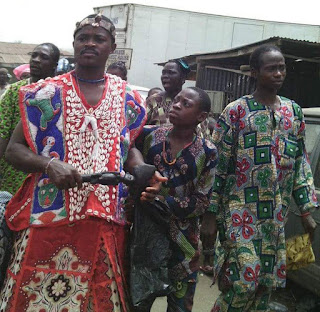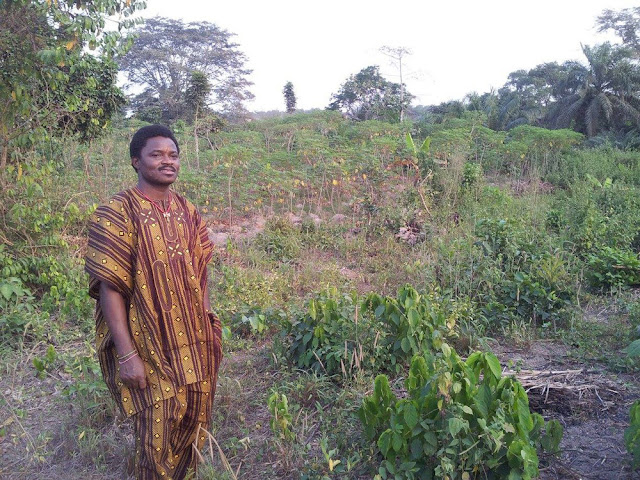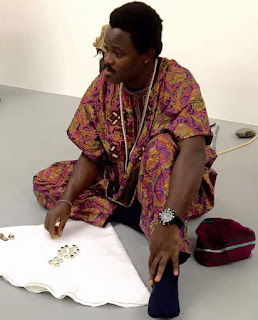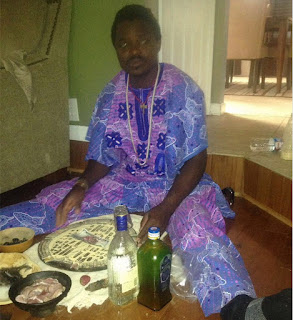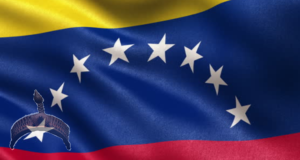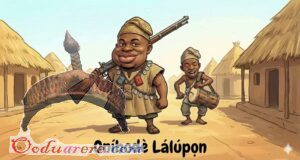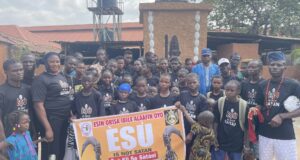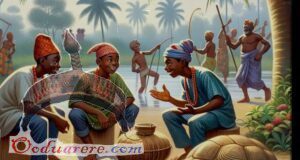Moussa: You are a son of Ṣàngódáre Àjàlá, a well-known artist and highly respected adóṣù Ṣàngó (Yor. adóṣù, someone who is initiated into Ṣàngó, lit. wearing tufts of hair). Àdùnní Olórìṣà Susanne Wenger was your grandmother. You grew up in a traditional Yorùbá household with many Òrìṣà culture and art around. Can you remember at what age you started to be involved into ceremonies?
Ṣàngóṣakin: I started from a very young age and was trained every day, as it is part of our family life. I went to school in the morning and when I came back I automatically got involved into the Òrìṣà traditions. I was learning from all the people surrounding me. It is important today that modern education and traditional training go hand in hand and work together. Without education there’s no development, people would stay in the same place. You have to know what is going on in the world.
Your family Òrìṣà is Ọbàtálá, you inherited the Òrìṣà from your ancestors. People who are not born as Yorùbá receive their personal Òrìṣà by initiation only. Can you tell us what this means, being born into an Ọbàtálá family?
Ọbàtálá is our family Òrìṣà but later also Ṣàngó came in, both are working together. Ọbàtálá is male and the oldest among the Òrìṣà, his color is white and he is responsible for the human creativity. Being born into an Ọbàtálá family means that all in your family are Ọbàtálá priests and priestesses and as a child you will get to know a lot about that Òrìṣà. You still can get initiated, so that you get closer to that Òrìṣà. If you are not born as Yorùbá you have to initiate or receive the Òrìṣà. Initiation means doing the full ritual, getting close to your chosen Òrìṣà and being reborn into a good life. The initiation procedure and the involved divination process will let you know more about yourself and your destiny. You also get your personal taboos, what to eat and what not to eat, which kind of color you should be wearing and so on. In contrast to initiation the receiving of an Òrìṣà for worship is like doing half an initiation. Òrìṣà in general are intermediary between us, the human beings, and Olódùmarè, God. Giving offerings is a way to be sure that everything is going well with Olódùmarè.
When have you been initiated into Ifa?
I did my complete Ifá Initiation, called ìtẹfá, when I was 15 years old.
Your name is Ṣàngóṣakin (Ṣàngó makes him a brave man). It was given to you after the Ẹsẹ̀ntáyé, the Yorùbá naming ceremony for babies. When did you first know that your Òrìṣà is Ṣàngó?
Ọbàtálá and Ṣàngó in general have a long tradition in my family. In my Ẹsẹ̀ntáyé ceremony it was already told to my parents that I am ọmọ Ṣàngó (child of Ṣàngó). Also when I did my Ifá initiation fifteen years later it came out in the Odù (sign of Ifá) that Ṣàngó is my Òrìṣà. That is why I fully initiated into Ṣàngó worship some years after doing my Ifá initiation.
You told me once, if I remember well, that every Ṣàngó initiation in Yorùbáland has to be done involving members from other Ṣàngó families?
I understand what you mean. Ṣàngó initiation is not an easy thing to do, we have to call on our friends from different towns to do the initiation together. That is why I mentioned the city of Ọ̀yọ́, but we also call Ṣàngó priests, bàtá drummers and friends from other towns like Ẹdẹ and so on. Another reason is that this also helps to establish good relationships and creates a community.
You mentioned in Ọ̀yọ́ the Ṣàngó tradition is different from Ọ̀ṣogbo. What are the differences?
There is no difference in the Òrìṣà worship itself. What I can say is that there exists more than one way how to reach a goal. If you want to go to the center, for example, someone might pass on the left side and another person passes on the right side – but at the end both meet at the center. That’s it.
Many Òrìṣà have different aspects, like there’s a young and an old Ọbàtálá. Do different aspects of Ṣàngó also exist? Is Ṣàngó just another name for Jàkúta or are they different entities?
Ṣàngó does not have different aspects. Ṣàngó is Ṣàngó. About Jàkúta – there are lots of stories on it. Some Ifá verses says that Jàkúta is a special day that they gave Ṣàngó for worship, there are long stories behind it. Ẹ̀rìndínlógún (cowry divination) verses say that Jàkúta is Ṣàngó’s son.
Why does Ṣàngó only take orógbó (bitter kola) and not normal obì àbàtà (four-lobbed kolanut)? Is there a story behind that?
There is not much on that, it was a choice by himself, he likes bitter kola. It makes him different from the other Òrìṣà and shows the power he has.
The ṣẹ́ẹ́rẹ́ Ṣàngó, the sacred gourd rattle, is specially prepared with medicine. Is it a symbol like the oṣẹ́ (double axe) or something different, because there is this medicine concealed in it?
Yes, there is a lot of medicine put into it before it gets used. The ṣẹ́ẹ́rẹ́ is a very powerful instrument to wake up and call the spirit of Ṣàngó. With the ṣẹ́ẹ́rẹ́ rattle he usually comes quick and accepts what we are saying.
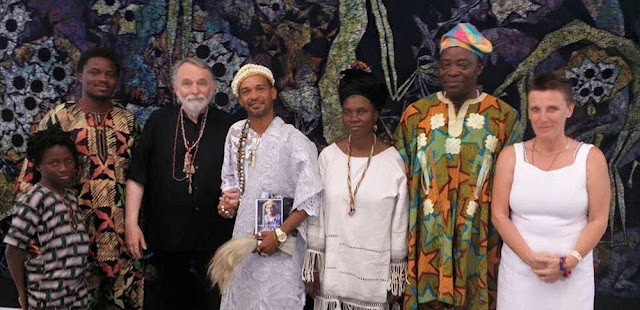
A meeting at the Susanne Wenger Foundation in Austria with Tokumbo, Sangosakin, Wolfgang Denk (founding director), Babalorixá Anderson Argolo from Salvador da Bahia, Wenger’s daughter Adedoyin Faniyi Olosun, Wenger’s son Sangodare Gbadegesin Ajala and Silvia Jura. In the background a huge batik of Susanne Wenger.
I think you also initiated into Ọ̀ṣun, after Ifá and before doing Ṣàngó, because as you said, after Ṣàngó you cannot do any other initiation. Ṣàngó claims the head for himself alone. Do you have two Òrìṣà put into your head now, Ọ̀ṣun and Ṣàngó?
No, I did not initiate into Ọ̀ṣun because after I did my Ifá initiation I already knew that I would have to be initiated into Ṣàngó, but I received Ọ̀ṣun. As I told before there’s a difference between receiving an Òrìṣà and initiating into an Òrìṣà. Ṣàngó is one of those Òrìṣà that are very strong and powerful, many things involved in his rituals are different to others. You cannot do Ṣàngó initiation on your head and do another Òrìṣà again later. All Ṣàngó devotees have a very important taboo: they are not allowed to shave their hair up to the skin. But this has to be done usually to every new initiate’s head. So after Ṣàngó there is no more initiation into any other Òrìṣà possible for you. So I did not do the complete Ọ̀ṣun Initiation, I just received her in a ceremony for my own worship. The two Òrìṣà that I put in my head are Ifá and Ṣàngó. People can put more Òrìṣà on their head. If someone wants to do Ṣàngó and also wants to have more than one Òrìṣà on his or her head, he or she will do the other Òrìṣà first and do Ṣàngó at last.
You belong to a young online generation of Olórìṣà in Nigeria. People from the diaspora, like Cuba or Brazil are looking to Nigeria to get to know more about Yorùbá spirituality. What is your experience with these transatlantic traditions from times of slavery?
Like I said before, school education is very important and it makes us connect to people from anywhere in the world. Back in Nigeria I had many foreign clients and I am having goddaughters and godsons in the diaspora. My experience is that there is a little difference from our own Yorùbá tradition to the ones abroad, likely because of the mixture of cultures in all those countries during the times of slavery. But I love and like connecting to people in the diaspora. I appreciate the love that people have for the Òrìṣà and it makes me feel happy. They made the Òrìṣà religion spread all over the whole world and that is why it is so popular today. Also because they don’t forget their roots. We Olórìṣà normally share our knowledge, work together and discuss about the religion and its different aspects.
Next to your father’s well known compound in Ọ̀sogbo there is a church, opposite a mosque. Are there any tensions between the different religions?
There is no tension. We Olórìṣà are doing our own thing and they are doing their own. What I personally think about their religions, both Christianity and Islam, is that they are not meant for us here in Africa. Christianity is meant for people in Europe, with Rome as its center, while Islam is meant for people in Arab countries. And Òrìṣà are meant for us in Africa.
How was life on university campus for you as a young Olórìṣà?
First it was very hard for me when I was admitted to college because I am a traditionalist. My mates and my lecturer have been brainwashed. But later it was getting better and fine, due to the arguments and discussions on religion we were having. Some agreed and some did not.
What Òrìṣà work do you offer to clients in your house in Ọ̀sogbo?
In our own ilé we do teach, research and initiate to different Òrìṣà. We do Ṣàngó entertainment performances and in general help people with spiritual problems. Also we create artworks in the studio. My father is doing his famous batik paintings and I also studied the art of casting bronze doing artwork for traditional worshippers.
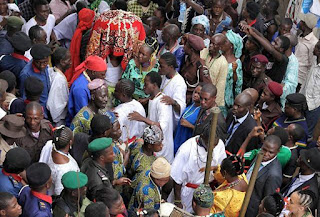
Sangosakin close to the arugba, the carrier of the sacred calabash (hidden under the red cloth) at the annual procession, bringing Oshun Oshogbo to the river
You are a Ṣàngó dancer in festivals, an ẹ̀lẹ́gùn Ṣàngó (someone who gets mounted) and I have seen photos of you in the beautiful Ṣàngó clothes, fire-breathing and even pushing knives into your body without getting hurt while the Òrìṣà is present in your body. Can you tell us about it?
I am really happy that I am a priest because if not I would not have got this talent. Being a trained Ṣàngó devotee gave me the opportunity to show my talents. Ṣàngó is very powerful. When you are in the traditional Ṣàngó cloth more power and more energy will come to you. You feel strong and the performance will be instructed by Ṣàngó himself. Even if you already have thought about some performance to do before you start, Ṣàngó can come up with a totally different plan. When you are in the Ṣàngó clothes you will not know or recognize anything, till Ṣàngó gets out of you. You may remember some stuff afterwards, but you cannot remember everything when they pull you out of Ṣàngó’s cloth.
You have been living for some months now in the USA, where your brother and his wife are also running a center for Yorùbá spirituality. I guess you have had the chance of meeting Olórìṣà from all over the world already. How is this experience for you?
Yes, my brother has the center called Ilé Àrìrà (house of Àrìrà, another name for Ṣàngó) in Maryland. Things are going on fine with the Yorùbá culture and tradition here. My experience here is very good, I really love it because I can meet different kinds of people from all over the world and also from different Yoruba based religions. We are sharing our knowledge and work hand in hand together.
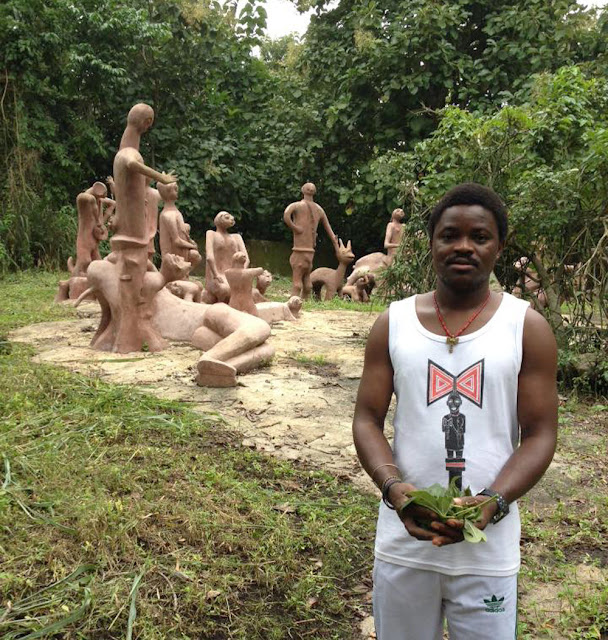
In the Grove of Oshun collecting leaves at the socalled Oja, the sacred marketplace for the Orisha and spirits (wearing a shirt by Orisha Image).
Thank you very much for the interview, ọ̀rẹ́ mi.
Ṣàngóṣakin Àjàlá is living in Maryland, USA. People interested in his work as Olórìṣà, Babaláwo and Ṣàngó dancer can contact him at the Ilé Àrìrà website or his personal account on Facebook.
https://www.facebook.com/ajala.sangosakin
 Ọmọ Oòduà Naija Gist | News From Nigeria | Entertainment gist Nigeria|Networking|News.. Visit for Nigeria breaking news , Nigerian Movies , Naija music , Jobs In Nigeria , Naija News , Nollywood, Gist and more
Ọmọ Oòduà Naija Gist | News From Nigeria | Entertainment gist Nigeria|Networking|News.. Visit for Nigeria breaking news , Nigerian Movies , Naija music , Jobs In Nigeria , Naija News , Nollywood, Gist and more


